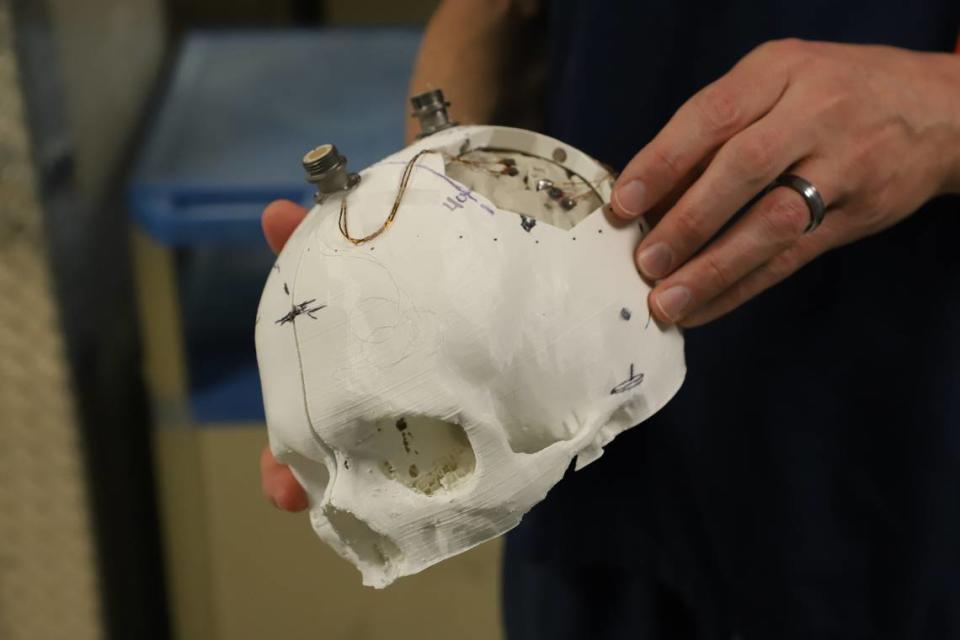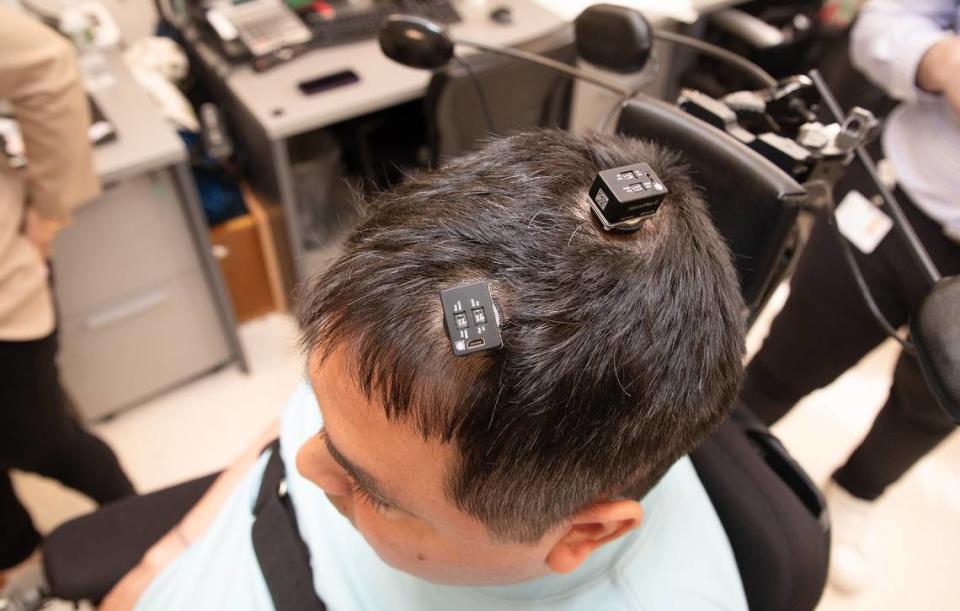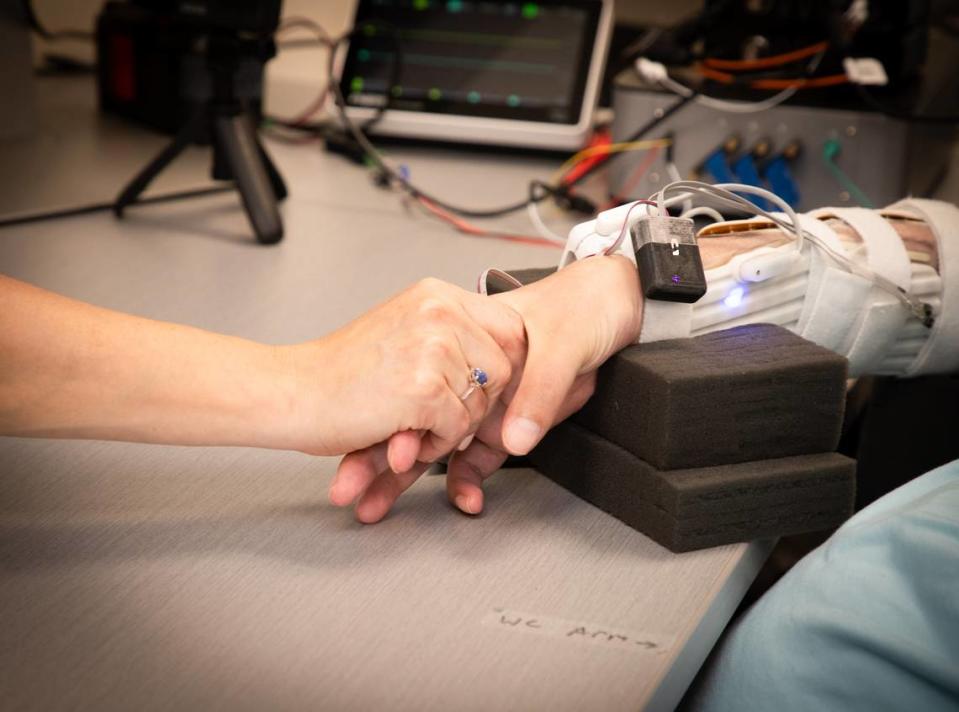Diving accident left man paralyzed. Now ‘historic’ treatment gives him second chance
It was a beautiful sunny day in July 2020 when 45-year-old Keith Thomas decided to take a dip in a backyard pool.
The New York resident stood on the water’s edge and took a leap, diving into the cool, blue oasis.
Then everything went black.
He woke up to a helicopter in the front lawn, and he was locked in his own body, unable to move from the chest down.
Thomas had a severe injury to his C4 and C5 vertebrae, two spinal bones at the bottom of the neck, according to a July 28 news release from Northwell Health’s Feinstein Institutes for Medical Research. Injuries to this area of the spine are known to be the most serious, and damage is done to the entire nervous system when these bones are compromised.
Sitting alone in a hospital room in the height of the COVID-19 pandemic, Thomas felt isolated. He was losing hope.
Then Chad Bouton, professor in the Institute of Bioelectronic Medicine at the Feinstein Institutes, walked into his room with a proposition.
Bouton was searching for participants in an experimental clinical trial that would use computer implants to bypass a section of the brain responsible for the sensation of touch and movement.
The trial, the first of its kind, would be tough, but Thomas was up for the challenge.

“The only thing I want to do is to help others. That’s always been the thing I’m best at,” Thomas said in the release. “If this can help someone even more than it’s helped me somewhere down the line, it’s all worth it.”
A 15-hour surgery
The researchers spent months mapping Thomas’ brain using a functional MRI, narrowing the areas that controlled his arm movement and the sensation of touch in his upper limbs.
On March 9, Thomas underwent a 15-hour, open-brain surgery at North Shore University Hospital in Manhasset on Long Island, conducted by a team of researchers, engineers and surgeons.
To make sure the surgeons found the right spots, Thomas was awake during the surgery and talked with the researchers about what he was feeling as they inserted probes into his brain.
“Because we had Keith’s images and he was talking to us during parts of his surgery, we knew exactly where to place the brain implants,” one of Thomas’ surgeons, Ashesh Mehta, said in the release. “We inserted two chips in the area responsible for movement and three more in the part of the brain responsible for touch and feeling in the fingers.”

The implants read Thomas’ intentions, meaning if he thinks about squeezing his paralyzed hand, the implant will identify that neural pathway and transmit it to a computer, connected to Thomas through ports in his head.
The computer then uses an artificial intelligence technology to read the signals from Thomas’ brain and translate it into an action.
“The computer then sends signals to highly-flexible, non-invasive electrode patches that are placed over his spine and hand muscles located in his forearm to stimulate and promote function and recovery,” according to the release.
The implants and electrode patches create a bridge between Thomas’ brain and his arm, bypassing the connection that was damaged from his diving injury. It allows his fully functioning brain to still tell his arm what to do, something that seemed impossible a few years ago.
Groundbreaking recovery
“In the lab, Mr. Thomas can now move his arms at will and can now feel his sister’s touch as she holds his hand in support,” according to the release.
The comfort of his sister was the first thing he felt in three years.
“There was a time that I didn’t know if I was even going to live, or if I wanted to, frankly. And now, I can feel the touch of someone holding my hand. It’s overwhelming,” Thomas said in the release.

In the four months since Thomas underwent the brain implantation, he started to have some natural recovery to his injured spine, the researchers said.
Thomas has increased his arm strength two-fold and is even experiencing sensation in his forearm and wrist when the computer is turned off.
His success gives hope to more than 100 million people worldwide who have movement impairment or paralysis, the researchers said.
“The hope is that the brain, body and spinal cord will relearn how to communicate and new pathways will be forged at the injury site thanks to the double neural bypass, similar to how a kidney can regenerate to overcome trauma or disease,” according to the release.
For Thomas, the future already looks brighter.
He told researchers he is grateful to be part of something “so historic and larger than himself,” according to the release.
Thomas is from Massapequa, on Long Island and about 30 miles east of Manhattan.
11-month-old’s partial heart transplant makes history in Texas. How doctors did it
Having long COVID could age your brain function an equivalent of 10 years, study says
Males lose sex chromosome as they age. It could make cancer more deadly, study says
Two kids - who are not related - develop insatiable appetite. Doctors find rare cause

